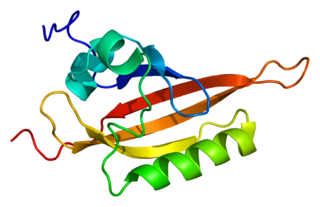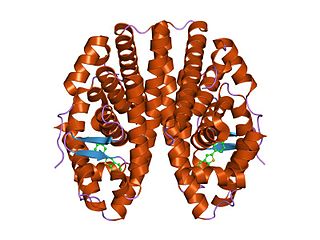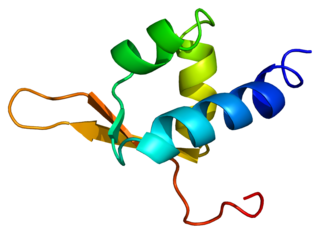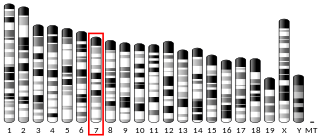Related Research Articles

The aryl hydrocarbon receptor is a protein that in humans is encoded by the AHR gene. The aryl hydrocarbon receptor is a transcription factor that regulates gene expression. It was originally thought to function primarily as a sensor of xenobiotic chemicals and also as the regulator of enzymes such as cytochrome P450s that metabolize these chemicals. The most notable of these xenobiotic chemicals are aromatic (aryl) hydrocarbons from which the receptor derives its name.

The ARNT gene encodes the aryl hydrocarbon receptor nuclear translocator protein that forms a complex with ligand-bound aryl hydrocarbon receptor (AhR), and is required for receptor function. The encoded protein has also been identified as the beta subunit of a heterodimeric transcription factor, hypoxia-inducible factor 1 (HIF1). A t(1;12)(q21;p13) translocation, which results in a TEL-ARNT fusion protein, is associated with acute myeloblastic leukemia. Three alternatively spliced variants encoding different isoforms have been described for this gene.

The nuclear receptor coactivator 2 also known as NCoA-2 is a protein that in humans is encoded by the NCOA2 gene. NCoA-2 is also frequently called glucocorticoid receptor-interacting protein 1 (GRIP1), steroid receptor coactivator-2 (SRC-2), or transcriptional mediators/intermediary factor 2 (TIF2).

Forkhead box protein P1 is a protein that in humans is encoded by the FOXP1 gene. FOXP1 is necessary for the proper development of the brain, heart, and lung in mammals. It is a member of the large FOX family of transcription factors.

Aryl hydrocarbon receptor nuclear translocator-like 2, also known as Mop9, Bmal2, Clif, or Arntl2, is a gene.

Metastasis-associated protein MTA1 is a protein that in humans is encoded by the MTA1 gene. MTA1 is the founding member of the MTA family of genes. MTA1 is primarily localized in the nucleus but also found to be distributed in the extra-nuclear compartments. MTA1 is a component of several chromatin remodeling complexes including the nucleosome remodeling and deacetylation complex (NuRD). MTA1 regulates gene expression by functioning as a coregulator to integrate DNA-interacting factors to gene activity. MTA1 participates in physiological functions in the normal and cancer cells. MTA1 is one of the most upregulated proteins in human cancer and associates with cancer progression, aggressive phenotypes, and poor prognosis of cancer patients.

Nuclear receptor-interacting protein 1 (NRIP1) also known as receptor-interacting protein 140 (RIP140) is a protein that in humans is encoded by the NRIP1 gene.

C-terminal-binding protein 1 also known as CtBP1 is a protein that in humans is encoded by the CTBP1 gene. CtBP1 is one of two CtBP proteins, the other protein being CtBP2.

E3 SUMO-protein ligase PIAS1 is an enzyme that in humans is encoded by the PIAS1 gene.

AH receptor-interacting protein (AIP) also known as aryl hydrocarbon receptor-interacting protein, immunophilin homolog ARA9, or HBV X-associated protein 2 (XAP-2) is a protein that in humans is encoded by the AIP gene. The protein is a member of the FKBP family.

Single-minded homolog 2 is a protein that in humans is encoded by the SIM2 gene. It plays a major role in the development of the central nervous system midline as well as the construction of the face and head.

Necdin is a protein that in humans is encoded by the NDN gene.

Nuclear receptor coactivator 7 is a protein that in humans is encoded by the NCOA7 gene.

Single-minded homolog 1, also known as class E basic helix-loop-helix protein 14 (bHLHe14), is a protein that in humans is encoded by the SIM1 gene.

Aryl hydrocarbon receptor nuclear translocator 2 is a protein that in humans is encoded by the ARNT2 gene.

Krueppel-like factor 9 is a protein that in humans is encoded by the KLF9 gene. Previously known as Basic Transcription Element Binding Protein 1, Klf9 is part of the Sp1 C2H2-type zinc finger family of transcription factors. Several previous studies showed Klf9-related regulation of animal development, including cell differentiation of B cells, keratinocytes, and neurons. Klf9 is also a key transcriptional regulator for uterine endometrial cell proliferation, adhesion, and differentiation, all factors that are essential during the process of pregnancy and are turned off during tumorigenesis.

General transcription factor IIF subunit 2 is a protein that in humans is encoded by the GTF2F2 gene.

Aryl hydrocarbon receptor nuclear translocator-like protein 1 (ARNTL) or Brain and Muscle ARNT-Like 1 (BMAL1) is a protein that in humans is encoded by the Bmal1 gene, also known as ARNTL, MOP3, and, less commonly, BHLHE5, BMAL, BMAL1C, JAP3, PASD3, and TIC.
Chemical Activated LUciferase gene eXpression (CALUX) is a ligand-dependent nuclear receptor-based bioassay used in the detection of specific chemicals or classes of chemicals in samples. It consists of a modified cell line that has been stably transfected with a DNA construct with a luciferase reporter gene under control of receptor-specific DNA response elements that can stimulate transcription of the inserted luciferase gene and produce the light-generating enzyme which can be easily measured. The DNA response elements can be varied in order to provide binding sites for other receptors that are regulated by a chemical or class of chemicals of interest that want to be detected. Thus, numerous CALUX bioassays have been developed for detection of diverse chemicals of interest. Most applications have been directed toward the detection of environmentally harmful chemicals, such as those affecting the endocrine system.

6-Formylindolo[3,2-b]carbazole (FICZ) is a chemical compound with the molecular formula C19H12N2O. It is a nitrogen heterocycle, having an extremely high affinity (Kd = 7 x 10−11M) for binding to the aryl hydrocarbon receptor (AHR).
References
- ↑ Baba T, Mimura J, Gradin K, Kuroiwa A, Watanabe T, Matsuda Y, Inazawa J, Sogawa K, Fujii-Kuriyama Y (August 2001). "Structure and expression of the Ah receptor repressor gene". J. Biol. Chem. 276 (35): 33101–10. doi: 10.1074/jbc.M011497200 . PMID 11423533.
- ↑ Evans BR, Karchner SI, Allan LL, Pollenz RS, Tanguay RL, Jenny MJ, Sherr DH, Hahn ME (February 2008). "Repression of aryl hydrocarbon receptor (AHR) signaling by AHR repressor: role of DNA binding and competition for AHR nuclear translocator". Mol. Pharmacol. 73 (2): 387–98. doi:10.1124/mol.107.040204. PMC 3263532 . PMID 18000031.
- ↑ Zudaire E, Cuesta N, Murty V, Woodson K, Adams L, Gonzalez N, Martínez A, Narayan G, Kirsch I, Franklin W, Hirsch F, Birrer M, Cuttitta F (February 2008). "The aryl hydrocarbon receptor repressor is a putative tumor suppressor gene in multiple human cancers". J. Clin. Invest. 118 (2): 640–50. doi:10.1172/JCI30024. PMC 2157559 . PMID 18172554.
- ↑ Kanno Y, Takane Y, Izawa T, Nakahama T, Inouye Y (June 2006). "The Inhibitory Effect of Aryl Hydrocarbon Receptor Repressor (AhRR) on the Growth of Human Breast Cancer MCF-7 Cells". Biol. Pharm. Bull. 29 (6): 1254–7. doi: 10.1248/bpb.29.1254 . PMID 16755028.
- ↑ Yamamoto J, Ihara K, Nakayama H, Hikino S, Satoh K, Kubo N, Iida T, Fujii Y, Hara T (January 2004). "Characteristic expression of aryl hydrocarbon receptor repressor gene in human tissues: organ-specific distribution and variable induction patterns in mononuclear cells". Life Sci. 74 (8): 1039–49. doi:10.1016/j.lfs.2003.07.022. PMID 14672759.